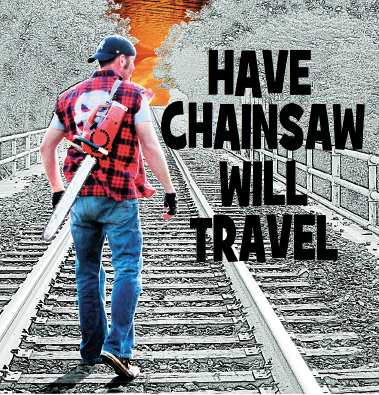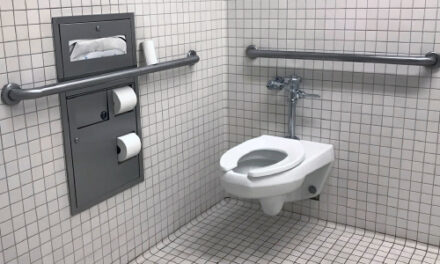
Many people frown on, some even look down upon and chastise anyone who “lowers” themselves to dumpster diving. But social etiquette and whatnot aside, sometimes it’d be foolish to pass up an opportunity. Case in point: here we have two pair of hand trucks tossed into the bin. One with a broken frame but good wheels, the other a good frame and no wheels….hmmm…did the same moron throw both of these away? Just put the good wheels on the good frame and voilá good hand trucks, which is good because the box is really heavy.
Seven “WARNINGS” and two “DANGER” assembly safety notes (all in English with pictorial references) precede three pages of assorted parts. If it’s that dangerous to assemble, how dangerous will it be once it’s assembled…if you survive the assembly?
Step 1 – Frame Assembly: “Locate the following 30 pieces of steel tubing that are needed to assemble the frame.” Locate them??? Aren’t they in the box? When the box is opened, do they jump out and hide? You should always make sure you have a sturdy framework so you have a firm foundation to build from. Making sure you have all the parts before you begin, there’s no point in starting something you cannot finish. Parts “located” (they were in the box) we can skip 3 more “WARNINGS” and the next 4 steps because there’s a YouTube video on this part.
Hmmm, apparently that video only works if you have two people to flip the frame once it’s assembled. Though it’s good to do things for yourself, it’s important to realize when you’ll need help. But at least it’s assembled correctly…upside down. We can look for easier ways to do things but often it’s best to reference the source material. Now to disassemble, follow the instructions and reassemble it right side up.
Steps 5 thru 8 – Spring Assembly: “When attaching the 72 springs they must be installed on opposing sides of the assembly to evenly distribute the tension.” It’s always best to try and evenly distribute tension so it’s easier to deal with, looking at the cause and effect of each spring as you go. Handling too much tension on one side will make things far more difficult on the other, which you will eventually have to deal with.
Step 9 – Lay Frame Pad so Springs and Steel Tubing are Covered: Said pad is the exact size and shape as the frame’s outer edge, so this bit of instruction seems unnecessary as it’s overly obvious where the pad will go. However, assumption can be the first step to failure and sometimes when things seem obvious they are not. Luckily in this case they are.
Step 10 – Assemble the Enclosure Poles: This bit of instruction is actually misleading as the enclosure poles were pre assembled, negating their need for assembly. Sometimes when things aren’t clear we have to employ logic and common sense to override confusion. You can’t “assemble” something that’s already assembled, but you can “attach” something to an assembly.
Step 11 – Connect the Enclosure Upper Frame to the Lower Frame: How? There is a lower and middle but no upper frame! Luckily there are pictures, which are worth a thousand words, which show we are actually assembling the upper frame and netting in this exercise. This doesn’t mean that reading is less important but in any situation you should utilize all available resources, pictorial or otherwise.
Step 12 – Attach Honeycomb Netting: Wait didn’t we just do that? Yes we attached some form of netting in the upper frame assembly. So why are we doing it again? It never hurts to double check or second guess something that seems questionable. In doing so it ensures that your course is still on course, of course. As it turns out this project is a double-netter.
Step 13 – Connect Upper Frame Tubes to Lower Frame Tubes: Ah, so here’s where the upper frame actually becomes upper. Now just lift the frame up via tube and…pulled muscle in rotary cup and lower back strain. Whether we like to admit it or not, some things are beyond our capability to do alone. It never hurts and there’s nothing wrong with asking for help and avoiding injury…physical or otherwise. However in the accompanying picture it clearly shows an extra person which is not provided by the manufacturer…I double-checked the box.
Step 14 – Tie Enclosure Netting to Triangular Frame Pieces: This step brings it all together by literally tying it all together. With any assembly, project or just about anything, it’s best to tie up all loose ends. Giving it a sense of completion and eliminating any future issues.
Well that’s that, the assembly is assembled. Who would have thought one could find so many basic life lessons in a Trampoline Assembly Instruction Manual? Now there are just two steps left to completely complete this project.
Step 15 – JUMP: I’ll leave this one to Gabriel the Grand-saw, formerly known as The Tot, it is his 7th Birthday present after all. Grammie, aka Lil Red, may have saved to purchase it and myself struggled to assemble it, but it is his to enjoy. Besides, my back and shoulder are killing me.
Step 16 – Enjoy, Savor, Relish: with the completion of any task, whether it be an assembly or daily activity, there comes a satisfying sense of completion. In some cases such as this the satisfaction comes after the fact. Wait for it…wait for it… there it is: that smile of pure joy you can only find on the face of a happy thankful child. That makes it all worthwhile, along with an understanding that to achieve some moments, some assembly is required.
I welcome almost all questions and comments via FOCUS, or email me at [email protected] .
Hope to hear from ya, until then try and stay focused. See ya!









